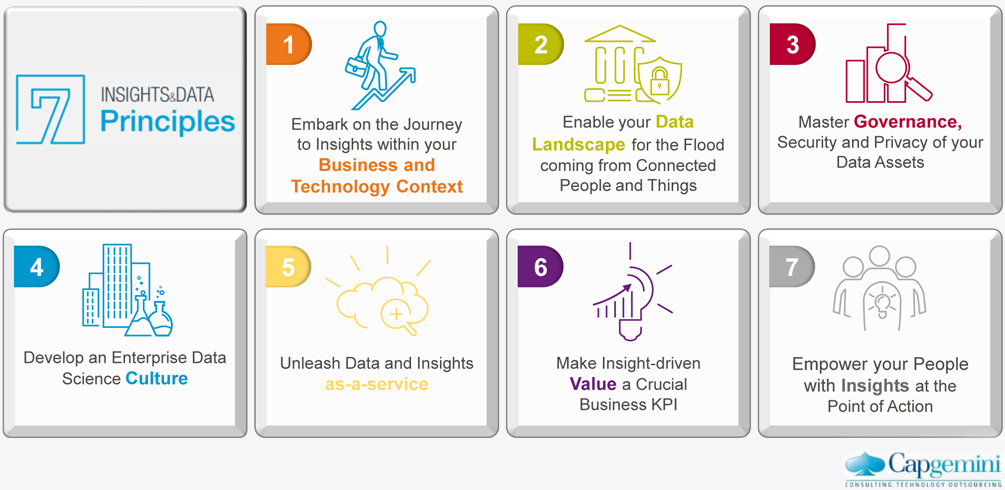Recent years have witnessed an unprecedented explosion in the availability of and access to data, which we must assimilate and deploy to their full potential.
Big data is the intersection of business strategy and data science, offering new opportunities to create competitive advantages. It allows companies to use data as a strategic asset, equipping them with pertinent real-time information when making decisions in order to eliminate inefficient operating processes, enhance the customer experience, take advantage of new markets, etc.
For many companies and businesses, big data is already a critical path to develop new products, services and business models, and it will surely become an increasingly important item on the agendas of managers and their teams.
The journey to big data begins with a series of curves. While the early steps are always unpredictable, opportunities will arise along the way. Data lie at the heart of the digital transformation, and the revolution consists of capitalizing on them, leveraging the value they offer to gain insight into what is happening and, above all, to predict what will happen and determine what needs to be done. This will enable the optimization and generation of business opportunities and new sources of income.
All the decisions people make at their organizations each day can be improved with data. It is thus important to cultivate a culture that values data and, in so doing, to capitalize not only on existing opportunities at the company itself, but also those arising around it. With the advent of the cloud and new technological solutions, big data has been democratized and now offers opportunities for companies of all sizes. We are currently evolving from having a multitude of unconnected databases toward models that integrate the entire information universe, perhaps in a less orderly fashion, but with a common database from which to extract what we need when we need it.
We need to start thinking in terms of unlimited volume, structures, and time. Information can be extracted from any digital element. Visual analyses and the generation of information through videos or images are thus already the order of the day and will only become more widespread.
With the advent of the cloud and new technological solutions, big data has been democratized and now offers opportunities for companies of all sizes.
The Cloud: A Key Point in Big Data Strategy
The cloud is a key component of big data strategy because there are far more data outside organizations than in them. Yet even now organizations continue to rely more on internal data than external data. This balance will soon begin to change, however, as data are increasingly stored in cloud services or accessed through APIs or external services.
When considering a big data strategy, we must also choose between keeping information in our own systems or using the cloud, where there are no limits or barriers and the link to any other data source is direct because we are already in the sea of data.
In the digital age, the ability to implement changes and business models quickly is vital, as is the ability to fail, learn from our mistakes, and correct them. Striking the right balance between investment and operating expenses is essential to avoid the constraints of making a very strong initial investment that locks us into a single course of action. We have to be able to start a new model or business and to do it fast. Cloud solutions make it easier to launch an online store, a big data platform, or an analytics solution quickly.
Analytics Everywhere
The concept of analytics is the key to operationalizing big data. Its value lies in reaching conclusions and detecting patterns in data that make it possible to predict events and prescribe actions that will positively impact businesses.
To date, tactical or strategic decision-making has not been part of the day-to-day, minute-by-minute routine. However, implementing analytics solutions allows us to optimize any transaction or business operation virtually in real time.
Operationalizing big data and analytics is the real source of opportunities. With any business model, we have to identify how advanced data analytics can be applied to improve a business or create a new one using the insights generated by algorithms and analytical models. Analytics can be used to optimize any point of a process. Today, embedding advanced analytics in business operations and, especially, in customer relations yields a competitive advantage, while failing to do so results in a short-term disadvantage.
Fully embracing the data revolution also involves certain challenges, many of them organizational: how to define the criteria to select each opportunity; how to quantify and measure the success of these initiatives; who should govern them and how; and who owns the data? To address all these questions, a new figure has emerged at organizations: the chief data officer.
Operationalizing big data and analytics is the real source of opportunities. With any business model, we have to identify how advanced data analytics can be applied to improve a business or create a new one.
The Seven Principles of an Insight-Driven Enterprise
Capgemini Insights & Data proposes seven principles to include the use of data in a company’s DNA. Think of them as a lever for transformation. To apply them, we need to understand the concept of business and technology with which we are starting and define the concept we want to get to:
- The first principle centers on defining our business objectives and focusing the data and our digital capabilities on a key point of our strategy to achieve them.
- Drawing on that strategy, the second principle is geared toward technological capacity-building. Not all company technology platforms are up to date and prepared for what is coming, not all are connected to external data sources and equipped to absorb everything, and not all are in the cloud and ready to start capitalizing on this information. Consequently, we need to enable a technology platform for this new model, under the new paradigm of working with “unlimited volume and time.”
- The goal of the third principle is to establish a suitable governance model. We must bear in mind that we are going to be handling third-party information, information from social media, information on positioning, customers’ personal data, and/or information on other business issues. Ensuring the privacy and security of how that information is processed and governed is thus extremely important, as is ensuring that the resulting ideas are launched in an environment of innovation and detecting when any of them fails in order to stop it in time. Not all ideas will yield value. In this environment, we thus have to be able to make mistakes quickly in order to learn quickly and change course. Without a defined governance model, the organization may react too late to possible missteps.
- The fourth principle is to cultivate a culture that values data. Anyone at a company can use data to identify how to improve tasks, processes, and everyday decision-making.
- The fifth principle is to think about the mode of consumption, which is also crucial, as the philosophy of using versus owning has changed. The new paradigm offers new ways to develop projects and make investments.
- The sixth principle is to quantify how much using the information impacts the bottom line and the percentage of business generated through monetization by applying data-driven insights. This should become another business KPI.
- Finally, the seventh principle is that the use of data-driven insights must be incorporated into the daily routines of everyone at the company and into every transaction. The real revolution lies in reinventing every business moment involving people, devices, and data.
Technology + Analysis + Change = Optimization
How to achieve all this? We need to work on three key areas: having the necessary technology; focusing on the right type of analytics; and identifying where the value lies in each business moment. Finally, we have to manage the change. And all of this has to be embedded in the operating model.
In short, big data, analytics, and the data revolution can be used to transform companies and impact their bottom lines, optimizing existing processes and business models, reinventing processes and business models, and generating new sources of income and business models.
© IE Insights.












